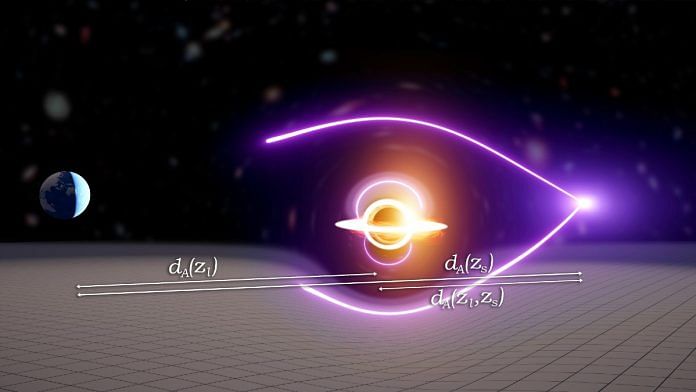Bengaluru: Analysis of light from a gamma-ray burst dating back three billion years ago has revealed the existence of a previously undetected black hole. The black hole is of intermediate mass, an elusive category of black holes that, until a few years ago, many scientists believed didn’t exist.
The gamma-ray burst, known as GRB 950830, was detected in 1995 when the light reached Earth. GRBs are the most energetic form of electromagnetic events in the universe, with short bursts of gamma rays being ejected at the speed of light.
A team of Australian researchers — James Paynter, Rachel Webster and Eric Thrane — from different institutions used the technique of gravitational lensing, where gravity around a massive body bends light coming from a source behind, to identify the intermediate-mass black hole (IMBH) that lensed the gamma-ray burst.
The findings were published in Nature Astronomy journal this week.
Also Read: Astrophysicists spot biggest black hole collision so far, and a mystery begins to unfurl
Gravitational lensing
Lensing is thought to occur when light from distant galaxies or events like gamma-ray bursts pass by massive objects in the universe, like stars or black holes.
The gravitational tug of these massive bodies can bend the light, causing the source to look distorted or appear in a different position.
When gravitational lensing is weak, it can distort the distant object or galaxy, making it appear magnified or stretched out. But when it is strong, it can bend light to such an extent that multiple images of the same galaxy are visible to us simultaneously.
Gravitational lensing is difficult to measure for individual galaxies, but clusters of galaxies tend to exhibit similar lensing patterns, enabling mathematical deduction.
Paynter, Webster (both from University of Melbourne) and Thrane (Monash University and OzGrav, the Australian Research Council Centre of Excellence for Gravitational Wave Discovery) combed through thousands of gamma-ray bursts looking for data that could point to gravitational lensing by objects that appear invisible.
Gamma-ray bursts are created when a high-mass star collapses and forms a neutron star or black hole.
Through extensive calculations, the authors concluded that this IMBH candidate likely carries a mass of tens of thousands solar masses.
Intermediate-mass black holes
IMBHs are a class of a black hole with a mass 100 to 100,000 times that of the Sun. There are two other types of black holes: the ones with a mass of less than 100 times that of the Sun are called stellar-mass black holes, while the ones with a mass greater than 100,000 times that — sometimes even billions of solar masses — are called supermassive black holes (SMBH).
Both stellar black holes and SMBHs are common. The closest black hole to Earth, a part of the system HR 6819, is active just 1,000 light years from us. The smallest known black hole is GRO J0422+32, discovered in 1992 at around 7,800 light years from Earth, which measures 2.1 times the solar mass.
Meanwhile, the centre of the Milky Way galaxy hosts a supermassive black hole called Sgr A* (pronounced “Sagittarius A star”) that is 26,000 light years from Earth and holds a mass of at least 40 lakh times the Sun’s. Every galaxy is theorised to have an SMBH at its centre, around which the entire galaxy revolves.
The first ever black hole detected, Cygnus X-1 in 1964, has 21 solar masses. Since then, researchers have discovered numerous black holes of the two extreme categories. But IMBHs — which have come to court the moniker “Goldilocks” in a reference drawn from the popular 19th-century fairytale — have been mysteriously difficult to detect.
Since 2004, new research has been published regularly with a handful of candidates, most claiming to be the “first evidence” of an IMBH. However, no findings have confirmed the existence of one directly yet.
In 2020, the Hubble Space Telescope provided the “best evidence” for an IMBH. This was followed by the detection of a gravitational wave from the merger of two IMBHs weighing 85 times and 66 times the solar mass.
The first direct picture of a black hole was obtained in 2019. It is the only black hole imaged directly, and the image has since been improved by mapping the magnetic fields around the SMBH.
Edited by Sunanda Ranjan
Also Read: ‘Missing’ supermassive black hole in distant galaxy leaves scientists perplexed



